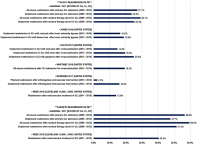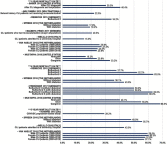The burden of critical limb ischemia: a review of recent literature
- PMID: 31308682
- PMCID: PMC6617560
- DOI: 10.2147/VHRM.S209241
The burden of critical limb ischemia: a review of recent literature
Abstract
Peripheral arterial disease is a chronic vascular disease characterized by impaired circulation to the lower extremities. Its most severe stage, known as critical limb ischemia (CLI), puts patients at an increased risk of cardiovascular events, amputation, and death. The objective of this literature review is to describe the burden of disease across a comprehensive set of domains-epidemiologic, clinical, humanistic, and economic-focusing on key studies published in the last decade. CLI prevalence in the United States is estimated to be approximately 2 million and is likely to rise in the coming years given trends in important risk factors such as age, diabetes, and smoking. Hospitalization for CLI patients is common and up to 60% are readmitted within 6 months. Amputation rates are unacceptably high with a disproportionate risk for certain demographic and socioeconomic groups. In addition to limb loss, CLI patients also have reduced life expectancy with mortality typically exceeding 50% by 5 years. Given the poor clinical prognosis, it is unsurprising that the quality of life burden associated with CLI is significant. Studies assessing quality of life in CLI patients have used a variety of generic and disease-specific measures and all document a substantial impact of the disease on the patient's physical, social, and emotional health status compared to population norms. Finally, the poor clinical outcomes and increased medical resource use lead to a considerable economic burden for national health care systems. However, published cost studies are not comprehensive and, therefore, likely underestimate the true economic impact of CLI. Our summary documents a sobering assessment of CLI burden-a poor clinical prognosis translating into diminished quality of life and high costs for millions of patients. Continued prevention efforts and improved treatment strategies are the key to ameliorating the substantial morbidity and mortality associated with this disease.
Keywords: amputation; burden; critical limb ischemia; economics; peripheral arterial disease; quality of life.
Conflict of interest statement
Steve Duff is an employee of Veritas Health Economics Consulting which was contracted to conduct the literature review. Michael S Mafilios is an employee of Health Economics Associates which was contracted to conduct the literature review. Prajakta Bhounsule and James T Hasegawa are employees of Abbott Vascular. The authors report no other conflicts of interest in this work.
Figures
References
-
- Gerhard-Herman MD, Gornik HL, Barrett C, et al. 2016 AHA/ACC guideline on the management of patients with lower extremity peripheral artery disease: a report of the American College of Cardiology/American Heart Association Task Force on clinical practice guidelines. J Am Coll Cardiol. 2017;69(11):e71–e126. doi:10.1016/j.jacc.2016.11.007 - DOI - PubMed
-
- Alonso A, Garcia LA. The costs of critical limb ischemia. Endovasc Today. 2011;32–36.
Publication types
MeSH terms
LinkOut - more resources
Full Text Sources
Medical
Research Materials
Miscellaneous



